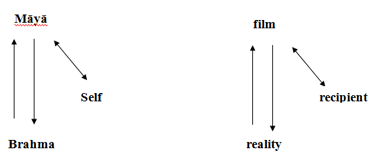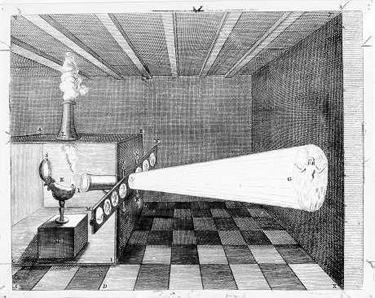Cinematic Identities... MAYA AND HER VEILS
|
Of course, what this chart conceals is that there is also a relation between the recipient and reality29. Films are, like Schopenhauer expressed it ante rem, magic lanterns that cast various images. But behind them lies only one truth, one will:
Wie eine Zauberlaterne viele und mannigfaltige Bilder zeigt, es aber nur eine und dieselbe Flamme ist, welche ihnen allen die Sichtbarkeit erteilt, so ist in ihren mannigfaltigen Erscheinungen, welche nebeneinander die Welt füllen, oder nacheinander als Begebenheiten sich verdrängen, doch nur der eine Wille das Erscheinende, dessen Sichtbarkeit, Objektität das Alles ist, und der unbewegt bleibt mitten in jenem Wechsel: er allein ist das Ding an sich: alles Objekt aber ist Erscheinung, Phänomen, in Kants Sprache zu reden30. But the recipient of a film remembers reality from outside the screening situation. This, however, does not diminish but rather actually reinforces the effect of the film. It gives it meaning outside itself. Again, this is a clear parallel to the way Plato thought we remembered the ιδέες, the ideas, when looking at their projected shadows on the cave wall. And it is the way Schopenhauer thought we could catch a glimpse of Brahma truth, of the will that underlies the world as representation - once we are able to either look behind Māyā's Veil or to tear it apart. Me and Mνημοσύνη31
Memories of dreams, of something imagined, and certainly memories of the perception of films can be as intense as memories of immediately and physically experienced first-hand events. Often they blur into each other, and they definitely change with every time we recall them. Popular culture has always made use of that second-hand memorial praxis. Many good films and good pop songs are openly regressive. Their memory-of-a-memory technique is essential for they way they are able to transport and reawaken emotional qualities connected to memory more intensely than to the live moment in time: Cast my memory back there, Lord Do you remember when, I remember when rock was young |
Now those memories come back to haunt me Film: For the Eyes of the Uncultured Only? Schopenhauer was not ready for a phenomenological turn38, for a praise of superficiality39: "The eyes of the uncultured (ungebildet) individual are clouded, as the Indians say, by the veil of Maya. To him is revealed not the thing-in-itself, but only the phenomenon in time and space, the principium individuationis"40. While aware of the moral and epistemological value of her unveiling, Schopenhauer turned a blind eye to the raging beauty of Māyā. Wenn nämlich vor den Augen eines Menschen jener Schleier der Maja, das principium individuationis, so sehr gelüftet ist, dass derselbe nicht mehr den egoistischen Unterschied zwischen seiner Person und der fremden macht, sondern an den Leiden der andern Individuen so viel Anteil nimmt wie an seinen eigenen und dadurch nicht nur im höchsten Grade hilfreich ist, sondern sogar bereit, sein eigenes Individuum zu opfern, sobald mehrere fremde dadurch zu retten sind; dann folgt von selbst, dass ein solcher Mensch, der in allen Wesen sich sein innerstes und wahres Selbst erkennt, auch die endlosen Leiden alles Lebenden als die seinen betrachten und so den Schmerz der ganzen Welt sich zueignen muss. [...] Wenn uns anderen, welche noch der Schleier der Maja umfängt, auch zu Zeiten im schwer empfundenen eigenen Leiden oder im lebhaft erkannten fremden, die Erkenntnis der Nichtigkeit und Bitterkeit des Lebens nahe tritt und wir durch völlige und auf immer entschiedene Entsagung den Begierden ihren Stachel abbrechen, allem Leiden den Zugang verschliessen, uns reinigen und heiligen möchten, so umstrickt uns doch bald wieder die Täuschung der Erscheinung, und ihre Motive setzen den Willen aufs Neue in Bewegung; wir können uns nicht losreissen41. While ridiculing Johann Gottlieb Fichte every chance he got, Schopenhauer himself was still deeply entangled in the mental traditions of German idealism.
Piercing Through Perception Without Māyā, we would be without perception and orientation, without any meaning at all. We could not see. The embodiment of ideas in Māyā, "the 'constructive power' (nirmānašakti) of the mind to 'project' (vikşepa) its objects that works in conjunction with the 'veiling power' (āvaranašakti) of avidyā to make a unitary metaphysical reality appear as the plurality of things in empirical experience"43 is essential to the possibility of any human experience at all. Of course, we know we can only receive the meaning that we ourselves have projected out onto the world before. That is why the natural sciences have lost their nimbus of being objectively analytical. They are projections, based on a specific set of rules, but nonetheless projections of the mind. They can – and should be – object to textual analyses and hermeneutic approaches themselves. It is their quality as human projections that makes them worthwhile being studied - pretty much the way other projections, be it film, dreams, art, material culture, are studied in the humanities, strictly the sciences of the human mind. Natural sciences are interesting to us, just because they have turned out to be dependent on our ability to project. It is not their alleged objectivity but rather their constructivist, syncretistic, synthesising qualities that make them interesting to us. In this spirit the negative judgement traditionally implied in Māyā should be reconsidered. In this light, the wan light of the projectors, Schopenhauer's summum bonum, the renunciation of the will, does not appeal to us as undoubtedly positive. Rather, it appears as quite hostile to the principle of culture which is necessarily always based on Māyā.
Andreas Ströhl |
----------------------------------
29 "Reality", however being "nur eine scheinbare, traumartige Existenz" (Die Welt als Wille und Vorstellung, 152), "only an illusive, dream-like existence" (The World as Will and Idea, 235), anyway.
30 Die Welt als Wille und Vorstellung, 121. "As the magic-lantern shows many different pictures, which are all made visible by one and the same light, so in all the multifarious phenomena which fill the world together or throng after each other as events, only one will manifests itself, of which everything is the visibility, the objectivity, and which remains unmoved in the midst of this change; it alone is the thing-in-itself; all objects are manifestations, or, to speak the language of Kant, phenomena." ( The World as Will and Idea , 199 f).
31 Mnemosyne, Greek goddess of memory.
32 Van Morrison: Brown Eyed Girl, 1967.
33 Kal Mann & Dave Appell: Let's Twist Again, 1961.
34 Elton John & Bernie Taupin: Crocodile Rock, 1970.
35 Bruce Springsteen: The River, 1980.
36 Billy Joel: Keeping the Faith, 1983.
37 Bruce Springsteen: Glory Days, 1984.
38 cf. his claim that "jedes vorhandene Ding rein objektiv und ausser aller Relation betrachtet werden kann" (Die Welt als Wille und Vorstellung, 178), that "it is possible to consider a real object [...] purely objectively" (The World as Will and Idea, 242). The English translation unfortunately and unrightfully suppresses Schopenhauer's very telling and important attribute "ausser aller Relation", "with disregard to all its relations".
39 After the title of a posthumous book by Vilém Flusser: Lob der Oberflächlichkeit. Für eine Phänomenologie der Medien. Bollmann, Bensheim and Düsseldorf 1993.
40 Schopenhauer, quoted after Berger, 190.
41 Die Welt als Wille und Vorstellung, 343 ff. "If that veil of Mâyâ, the principium individuationis, is lifted from the eyes of a man to such an extent that he no longer makes the egoitistical distinction between his person and that of others, but takes as much interest in the sufferings of other individuals as in his own, and therefore is not only benevolent in the highest degree, but even ready to sacrifice his own individuality whenever such a sacrifice will save a number of other persons, then it clearly follows that such a man, who recognises in all beings his own inmost and true self, must also regard the infinite suffering of all suffering beings as his own, and take on himself the pain of the whole world. [...] If at times, in the hard experience of our own suffering, or in the vivid recognition of that of others, the knowledge of the vanity and bitterness of life draws nigh to us also who are still wrapt in the veil of Mâyâ, and we would like to destroy the sting of the desires, close the entrance against all suffering, and purify and sanctify ourselves by complete and final renunciation; yet the illusion of the phenomenon soon entangles us again, and its motives influence the will anew; we cannot tear ourselves free." (The World as Will and Idea, 489 f).
42 Kinsley, 104.
43 Berger, 62 f.




 The Platonic concept of why we remember ideas, and under which difficulties, implies the belief in reincarnation. Briefly, in his reminiscence theory, Plato holds that knowing is remembering. Our soul had had access to the world of the ideas before it incarnated in our body. It brought along those memories. The vague memory, άνάμνησις (anamnesis), of previous experience and of eternal ideas predefines what we can learn and experience in our current lives. Before it is reincarnated into a body, the soul must drink the water of the river Ameles in the plain of Lethe in order to erase its memory of both the previous life and the beyond.
The Platonic concept of why we remember ideas, and under which difficulties, implies the belief in reincarnation. Briefly, in his reminiscence theory, Plato holds that knowing is remembering. Our soul had had access to the world of the ideas before it incarnated in our body. It brought along those memories. The vague memory, άνάμνησις (anamnesis), of previous experience and of eternal ideas predefines what we can learn and experience in our current lives. Before it is reincarnated into a body, the soul must drink the water of the river Ameles in the plain of Lethe in order to erase its memory of both the previous life and the beyond. Māyā has negative connotations in Hindu philosophy and mythology [...]. Māyā is that which deludes individuals into thinking themselves to be the center of the world, the power that prevents individuals from seeing things as they really are. Māyā is that which impels individuals into self-centered, egotistical actions. Māyā is the sense of ego, personal identity, and individuality which clouds the underlying unity of reality and masks one's essential identity with brahman or some exalted being such as Vişņu, Śiva, or Durgā . Māyā, however, may also be understood as a positive, creative force not unlike śakti. Māyā may be understood as the power that enables a deity to display or embody himself or herself and therefore as the power that enables a deity to act42.
Māyā has negative connotations in Hindu philosophy and mythology [...]. Māyā is that which deludes individuals into thinking themselves to be the center of the world, the power that prevents individuals from seeing things as they really are. Māyā is that which impels individuals into self-centered, egotistical actions. Māyā is the sense of ego, personal identity, and individuality which clouds the underlying unity of reality and masks one's essential identity with brahman or some exalted being such as Vişņu, Śiva, or Durgā . Māyā, however, may also be understood as a positive, creative force not unlike śakti. Māyā may be understood as the power that enables a deity to display or embody himself or herself and therefore as the power that enables a deity to act42.